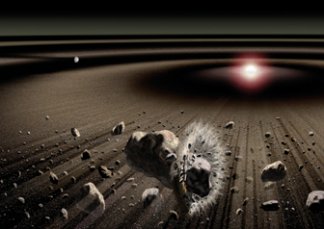A dusty birthplace
Evidence of separate bands of dust suggests the presence of a planet orbiting a young star.
By Emily Sohn
Outer space is a messy place. Besides all the asteroids, comets, and planets floating around, disks of dust particles surround many young stars.
A recent analysis is revealing new information about one particularly famous dust disk. This disk hovers around a star called Beta Pictoris. The research points to a possible planet orbiting the star, plus a collection of asteroids and comets.
 |
|
An artist illustrates what a possible planet (upper left) might look like when flanked by bands of dust within the disk surrounding the star Beta Pictoris (upper right).
|
| © K. Kanba, ISAS/JAXA |
Scientists have known about the dusty disk around Beta Pictoris for 20 years. Many details, though, have long been missing.
The dust that often surrounds young stars comes from all the action that happens nearby, as planets, asteroids, and comets form and then slam into each other.
To learn what the dust around Beta Pictoris is made of, astronomers from Japan used an infrared camera on a telescope in Hawaii. The images showed three distinct bands of tiny dust particles.
To describe how far these bands are from the star, the scientists used a distance measurement called an astronomical unit (AU). One AU is equal to the distance between the sun and Earth.
Around Beta Pictoris, the closest band of dust is 6.4 AU from the star. The other two bands lie at distances of 16 and 30 AU.
Normally, it would take less than 100 years for the tiny dust particles to be blown away into space. The fact that the disk around Beta Pictoris is still present suggests that some process is constantly restocking the particles that make up the bands, the scientists say. One possibility is collisions between asteroids.
There might also be a planet at a distance of 12 AU from the star, the data suggest. That’s just slightly greater than Saturn’s distance from the sun. This planet’s gravity could be helping to keep the dust belts from flying away into space and dispersing.
Further studies may provide additional details about how objects in the universe form and change. Tidiness probably has nothing to do with it!
Going Deeper:
Cowen, Ron. 2004. Planet signs? Sifting a dusty disk. Science News 166(Oct. 9):227-228. Available at http://www.sciencenews.org/articles/20041009/fob2.asp .
You can learn more about Beta Pictoris at antwrp.gsfc.nasa.gov/apod/ap971128.html and antwrp.gsfc.nasa.gov/apod/ap980122.html (NASA Goddard Space Flight Center) and hubblesite.org/newscenter/newsdesk/archive/
releases/1996/02/text/ (Space Telescope Science Institute).







